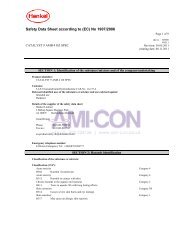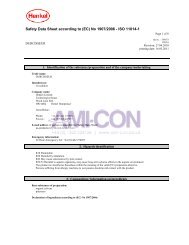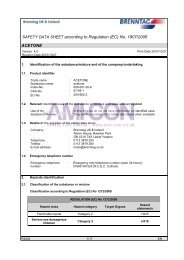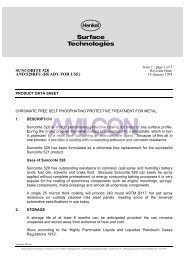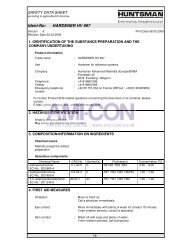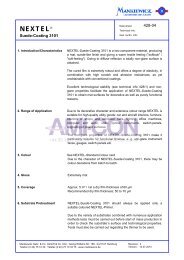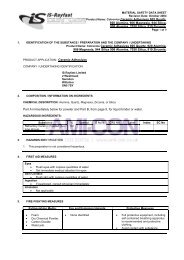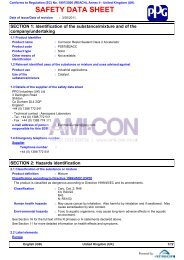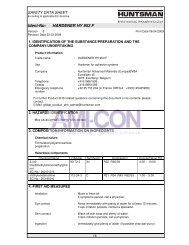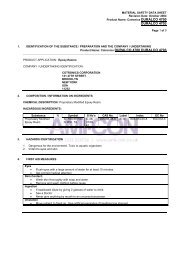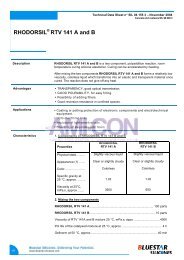ACC Silicones LTD SGM494 - AMI-CON
ACC Silicones LTD SGM494 - AMI-CON
ACC Silicones LTD SGM494 - AMI-CON
You also want an ePaper? Increase the reach of your titles
YUMPU automatically turns print PDFs into web optimized ePapers that Google loves.
<strong>ACC</strong> <strong>Silicones</strong> <strong>LTD</strong><br />
<strong>SGM494</strong><br />
Safety Data Sheet<br />
1. Identification of the substance/mixture and of the company/undertaking<br />
1.1. Product identifier<br />
Revision nr.3<br />
Dated 01/06/2012<br />
Printed on 26/06/2012<br />
Page n. 1 / 5<br />
EN<br />
Product name<br />
<strong>SGM494</strong><br />
1.2. Relevant identified uses of the substance or mixture and uses advised against<br />
Intended use<br />
Silicone grease<br />
1.3. Details of the supplier of the safety data sheet<br />
Name<br />
<strong>ACC</strong> <strong>Silicones</strong> <strong>LTD</strong><br />
Full address<br />
Amber House Showground Road<br />
District and Country TA6 6AJBridgwater (Somerset)<br />
England<br />
Tel. +44(0)1278411400<br />
Fax +44(0)1278411444<br />
e-mail address of the competent person<br />
responsible for the Safety Data Sheet<br />
sean.stoodley@acc-silicones.com<br />
1.4. Emergency telephone number<br />
For urgent inquiries refer to +44(0)1278411400<br />
2. Hazards identification.<br />
2.1. Classification of the substance or mixture.<br />
The product is not classified as hazardous pursuant to the provisions set forth in Directives 67/548/EEC and 1999/45/EC and/or EC<br />
Regulation 1272/2008 (CLP) (and subsequent amendments and supplements).<br />
2.2. Label elements.<br />
Pictograms: --<br />
Warning: --<br />
Hazard indication: --<br />
Caution recommendations: --<br />
2.3. Other hazards.<br />
Information not available.<br />
3. Composition/information on ingredients.<br />
3.1. Substances.<br />
Information not relevant.<br />
3.2. Mixtures.<br />
The product does not contain substances classified as being hazardous to human health or the environment pursuant to the provisions<br />
set forth in Directives 67/548/EEC and/or EC Regulation 1272/2008 (CLP) (and subsequent amendments and supplements).<br />
4. First aid measures.<br />
4.1. Description of first aid measures.<br />
No harm to the staff authorised to use has been reported. However, in case of contact, inhalation or ingestion, the following general<br />
measures provided for a first aid shall be taken.<br />
INHALATION: remove to open air. If respiration is difficult, administer artificial respiration and seek medical advice.<br />
MSDS EPY 1002
<strong>ACC</strong> <strong>Silicones</strong> <strong>LTD</strong><br />
<strong>SGM494</strong><br />
Revision nr.3<br />
Dated 01/06/2012<br />
Printed on 26/06/2012<br />
Page n. 2 / 5<br />
EN<br />
INGESTION: seek medical attention. Induce vomiting only if indicated by the doctor. Never give anything by mouth to an unconscious<br />
person.<br />
EYES and SKIN: wash with plenty of water; if the irritation persists, seek medical advice.<br />
4.2. Most important symptoms and effects, both acute and delayed.<br />
No episodes of damage to health ascribable to the product have been reported.<br />
4.3. Indication of any immediate medical attention and special treatment needed.<br />
Follow doctor's orders.<br />
5. Firefighting measures.<br />
5.1. Extinguishing media.<br />
SUITABLE EXTINGUISHING MEDIA<br />
The extinction equipment should be of the conventional kind: carbon dioxide, foam, powder and nebulised water.<br />
EXTINGUISHING MEDIA WHICH SHALL NOT BE USED FOR SAFETY REASONS<br />
None in particular.<br />
5.2. Special hazards arising from the substance or mixture.<br />
HAZARDS CAUSED BY EXPOSURE IN THE EVENT OF FIRE<br />
Do not breathe combustion products (carbon oxide, toxic pyrolysis products, etc).<br />
5.3. Advice for firefighters.<br />
GENERAL INFORMATION<br />
Use jets of water to cool the containers to prevent product decomposition and the development of substances potentially hazardous for<br />
health. Always wear full fire prevention gear. Collect extinguishing water to prevent it from draining into the sewer system. Dispose of<br />
contaminated water used for extinction and the remains of the fire according to applicable regulations.<br />
SPECIAL PROTECTIVE EQUIPMENT FOR FIRE-FIGHTERS<br />
Hardhat with visor, fireproof clothing (fireproof jacket and trousers with straps around arms, legs and waist), work gloves (fireproof, cut<br />
proof and dielectric), a depressurised mask with facemask covering the whole of the operator’s face or a self-respirator (self-protector) in<br />
the event of large quantities of fume.<br />
6. Accidental release measures.<br />
6.1. Personal precautions, protective equipment and emergency procedures.<br />
Eliminate all sources of ignition (cigarettes, flames, sparks, etc.) from the leakage site. If there are no contraindications, spray solid<br />
products with water to prevent the formation of dust. Use breathing equipment if fumes or powders are released into the air. Block the<br />
leakage if there is no hazard. Do not handle damaged containers or the leaked product before donning appropriate protective gear. For<br />
information on risks for the environmental and health, respiratory tract protection, ventilation and personal protection equipment, see the<br />
other sections of this sheet.<br />
6.2. Environmental precautions.<br />
The product must not penetrate the sewers, surface water, ground water and neighbouring areas.<br />
6.3. Methods and material for containment and cleaning up.<br />
Use inert absorbent material (sand, vermiculite, diatomeous earth, Kieselguhr, etc.) to soak up leaked product. Collect the majority of the<br />
remaining material and deposit it in containers for disposal. If there are no contraindications, use jets of water to eliminate product<br />
residues. Make sure the leakage site is well aired. Contaminated material should be disposed of in compliance with the provisions set<br />
forth in point 13.<br />
6.4. Reference to other sections.<br />
Any information on personal protection and disposal is given in sections 8 and 13.<br />
7. Handling and storage.<br />
7.1. Precautions for safe handling.<br />
Do not smoke while handling and use.<br />
7.2. Conditions for safe storage, including any incompatibilities.<br />
Store in a well ventilated place, keep far away from sources of heat, bright flames and sparks and other sources of ignition.<br />
7.3. Specific end use(s).<br />
Information not available.<br />
MSDS EPY 1002
<strong>ACC</strong> <strong>Silicones</strong> <strong>LTD</strong><br />
<strong>SGM494</strong><br />
Revision nr.3<br />
Dated 01/06/2012<br />
Printed on 26/06/2012<br />
Page n. 3 / 5<br />
EN<br />
8. Exposure controls/personal protection.<br />
8.1. Control parameters.<br />
Information not available.<br />
8.2. Exposure controls.<br />
Observance of safety measures used in handling chemical substances.<br />
RESPIRATORY PROTECTION<br />
None required.<br />
EYE PROTECTION<br />
None required.<br />
HAND PROTECTION<br />
None required.<br />
SKIN PROTECTION<br />
None required.<br />
9. Physical and chemical properties.<br />
9.1. Information on basic physical and chemical properties.<br />
Appearance<br />
paste<br />
Colour<br />
colourless<br />
Odour<br />
characteristic<br />
Odour threshold.<br />
Not available.<br />
pH.<br />
Not available.<br />
Melting or freezing point.<br />
Not available.<br />
Boiling point.<br />
Not available.<br />
Distillation range.<br />
Not available.<br />
Flash point. > 150 °C.<br />
Evaporation Rate<br />
Not available.<br />
Flammability of solids and gases<br />
Not available.<br />
Lower inflammability limit.<br />
Not available.<br />
Upper inflammability limit.<br />
Not available.<br />
Lower explosive limit.<br />
Not available.<br />
Upper explosive limit.<br />
Not available.<br />
Vapour pressure.<br />
Not available.<br />
Vapour density<br />
Not available.<br />
Specific gravity.<br />
Not available.<br />
Solubility<br />
immiscible with water<br />
Partition coefficient: n-octanol/water<br />
Not available.<br />
Ignition temperature. > 400 °C.<br />
Decomposition temperature.<br />
Not available.<br />
Viscosity<br />
Not available.<br />
Reactive Properties<br />
Not available.<br />
9.2. Other information.<br />
VOC (Directive 1999/13/EC) : 0<br />
VOC (volatile carbon) : 0<br />
10. Stability and reactivity.<br />
10.1. Reactivity.<br />
There are no particular risks of reaction with other substances in normal conditions of use.<br />
10.2. Chemical stability.<br />
The product is stable in normal conditions of use and storage.<br />
10.3. Possibility of hazardous reactions.<br />
No hazardous reactions are foreseeable in normal conditions of use and storage.<br />
10.4. Conditions to avoid.<br />
None in particular, however the usual precautions used for chemical products should be respected.<br />
10.5. Incompatible materials.<br />
Information not available.<br />
MSDS EPY 1002
<strong>ACC</strong> <strong>Silicones</strong> <strong>LTD</strong><br />
<strong>SGM494</strong><br />
Revision nr.3<br />
Dated 01/06/2012<br />
Printed on 26/06/2012<br />
Page n. 4 / 5<br />
EN<br />
10.6. Hazardous decomposition products.<br />
In the event of thermal decomposition or fire, vapours potentially dangerous to health may be released.<br />
11. Toxicological information.<br />
According to currently available data, this product has not yet produced health damages. Anyway, it must be handled carefully according<br />
to good industrial practices. This product may have slight health effects on sensitive people, by inhalation and/or cutaneous absorption<br />
and/or contact with eyes and/or ingestion.<br />
11.1. Information on toxicological effects.<br />
Information not available.<br />
12. Ecological information.<br />
Use this product according to good working practices. Avoid littering. Inform the competent authorities, should the product reach<br />
waterways or sewers or contaminate soil or vegetation.<br />
12.1. Toxicity.<br />
Information not available.<br />
12.2. Persistence and degradability.<br />
Information not available.<br />
12.3. Bioaccumulative potential.<br />
Information not available.<br />
12.4. Mobility in soil.<br />
Information not available.<br />
12.5. Results of PBT and vPvB assessment.<br />
Information not available.<br />
12.6. Other adverse effects.<br />
Information not available.<br />
13. Disposal considerations.<br />
13.1. Waste treatment methods.<br />
Reuse, when possible. Neat product residues should be considered special non-hazardous waste.<br />
Disposal must be performed through an authorised waste management firm, in compliance with national and local regulations.<br />
<strong>CON</strong>T<strong>AMI</strong>NATED PACKAGING<br />
Contaminated packaging must be recovered or disposed of in compliance with national waste management regulations.<br />
14. Transport information.<br />
The product is not dangerous under current provisions of the Code of International Carriage of Dangerous Goods by Road (ADR) and by<br />
Rail (RID), of the International Maritime Dangerous Goods Code (IMDG), and of the International Air Transport Association (IATA)<br />
regulations.<br />
15. Regulatory information.<br />
15.1. Safety, health and environmental regulations/legislation specific for the substance or mixture.<br />
Seveso category.<br />
None.<br />
Restrictions relating to the product or contained substances pursuant to Annex XVII to EC Regulation 1907/2006.<br />
None.<br />
Substances in Candidate List (Art. 59 REACH).<br />
None.<br />
Substances subject to authorisarion (Annex XIV REACH).<br />
None.<br />
MSDS EPY 1002
<strong>ACC</strong> <strong>Silicones</strong> <strong>LTD</strong><br />
<strong>SGM494</strong><br />
Revision nr.3<br />
Dated 01/06/2012<br />
Printed on 26/06/2012<br />
Page n. 5 / 5<br />
EN<br />
Healthcare controls.<br />
Information not available.<br />
15.2. Chemical safety assessment.<br />
No chemical safety assessment has been processed for the mixture and the substances it contains.<br />
16. Other information.<br />
GENERAL BIBLIOGRAPHY<br />
1. Directive 1999/45/EC and following amendments<br />
2. Directive 67/548/EEC and following amendments and adjustments<br />
3. Regulation (EC) 1907/2006 (REACH) of the European Parliament<br />
4. Regulation (EC) 1272/2008 (CLP) of the European Parliament<br />
5. Regulation (EC) 790/2009 (I Atp. CLP) of the European Parliament<br />
6. Regulation (EC) 453/2010 of the European Parliament<br />
7. The Merck Index. - 10th Edition<br />
8. Handling Chemical Safety<br />
9. Niosh - Registry of Toxic Effects of Chemical Substances<br />
10. INRS - Fiche Toxicologique (toxicological sheet)<br />
11. Patty - Industrial Hygiene and Toxicology<br />
12. N.I. Sax - Dangerous properties of Industrial Materials-7, 1989 Edition<br />
Note for users:<br />
The information contained in the present sheet are based on our own knowledge on the date of the last version. Users must verify the<br />
suitability and thoroughness of provided information according to each specific use of the product .<br />
This document must not be regarded as a guarantee on any specific product property.<br />
The use of this product is not subject to our direct control; therefore, users must, under their own responsibility, comply with the current<br />
health and safety laws and regulations. The producer is relieved from any liability arising from improper uses.<br />
Changes to previous review:<br />
The following sections were modified:<br />
01 / 02.<br />
MSDS EPY 1002


